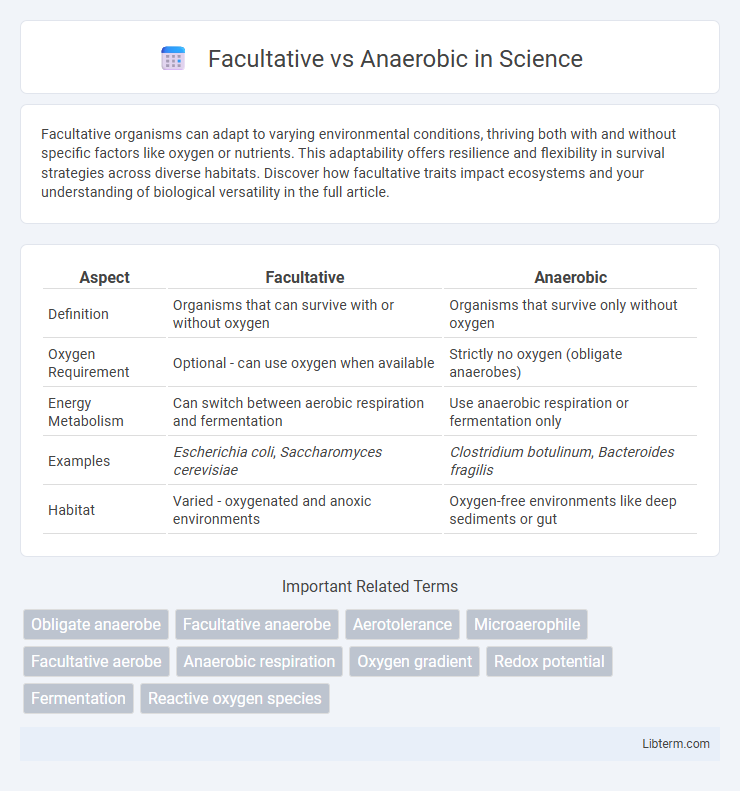Facultative organisms can adapt to varying environmental conditions, thriving both with and without specific factors like oxygen or nutrients. This adaptability offers resilience and flexibility in survival strategies across diverse habitats. Discover how facultative traits impact ecosystems and your understanding of biological versatility in the full article.
Table of Comparison
| Aspect | Facultative | Anaerobic |
|---|---|---|
| Definition | Organisms that can survive with or without oxygen | Organisms that survive only without oxygen |
| Oxygen Requirement | Optional - can use oxygen when available | Strictly no oxygen (obligate anaerobes) |
| Energy Metabolism | Can switch between aerobic respiration and fermentation | Use anaerobic respiration or fermentation only |
| Examples | Escherichia coli, Saccharomyces cerevisiae | Clostridium botulinum, Bacteroides fragilis |
| Habitat | Varied - oxygenated and anoxic environments | Oxygen-free environments like deep sediments or gut |
Introduction to Facultative and Anaerobic Organisms
Facultative organisms possess metabolic flexibility, allowing them to survive in both oxygen-rich and oxygen-poor environments by switching between aerobic respiration and anaerobic processes like fermentation. Anaerobic organisms, on the other hand, thrive exclusively in oxygen-free conditions, often using fermentation or anaerobic respiration to generate energy. Understanding the metabolic mechanisms of facultative and anaerobic organisms is essential in microbiology for applications ranging from industrial fermentation to medical research on infectious diseases.
Definition of Facultative Organisms
Facultative organisms can survive in both the presence and absence of oxygen, adapting their metabolism to aerobic or anaerobic conditions based on environmental availability. These organisms switch between aerobic respiration when oxygen is abundant and anaerobic respiration or fermentation when oxygen is scarce. This metabolic flexibility distinguishes facultative microorganisms from obligate anaerobes, which cannot tolerate oxygen, and obligate aerobes, which require it for survival.
Definition of Anaerobic Organisms
Anaerobic organisms are microorganisms that do not require oxygen for growth and can survive in environments devoid of oxygen, often relying on fermentation or anaerobic respiration to generate energy. These organisms contrast with facultative anaerobes, which can grow with or without oxygen by switching between aerobic respiration and anaerobic metabolism. Examples of anaerobic bacteria include Clostridium species, which thrive in oxygen-free environments and play critical roles in processes like fermentation and soil nutrient cycling.
Core Differences Between Facultative and Anaerobic
Facultative organisms can survive in both the presence and absence of oxygen, using aerobic respiration when oxygen is available and switching to anaerobic respiration or fermentation when it is not. Anaerobic organisms, however, strictly thrive in oxygen-free environments and rely solely on anaerobic respiration or fermentation for energy production. This fundamental metabolic flexibility distinguishes facultative bacteria like Escherichia coli from obligate anaerobes such as Clostridium species.
Types of Facultative Bacteria
Facultative bacteria are versatile microorganisms capable of surviving in both aerobic and anaerobic environments by switching between oxygen-dependent respiration and fermentation or anaerobic respiration. Types of facultative bacteria include Escherichia coli, which thrives in the human gut, Staphylococcus aureus, known for causing infections under aerobic or anaerobic conditions, and Salmonella species, responsible for foodborne illnesses. These facultative bacteria play significant roles in clinical, environmental, and industrial contexts due to their metabolic adaptability.
Types of Anaerobic Bacteria
Facultative anaerobic bacteria can survive in both oxygen-rich and oxygen-poor environments by switching between aerobic respiration and anaerobic fermentation. Obligate anaerobic bacteria, a key type of anaerobic bacteria, cannot tolerate oxygen and rely solely on anaerobic metabolism for energy production. Other types include aerotolerant anaerobes, which do not use oxygen but can survive its presence, and microaerophiles that require low oxygen levels for growth.
Metabolic Pathways: Facultative vs Anaerobic
Facultative organisms switch between aerobic respiration and anaerobic metabolism, utilizing oxygen when available for efficient ATP production but resorting to fermentation or anaerobic respiration pathways in its absence. Anaerobic organisms rely exclusively on anaerobic metabolic pathways such as fermentation or anaerobic respiration, using alternate electron acceptors like nitrate, sulfate, or carbon dioxide instead of oxygen. The key distinction lies in facultative metabolism's flexibility to optimize energy generation based on oxygen availability, whereas strict anaerobes permanently depend on oxygen-independent processes.
Environmental Adaptability and Survival
Facultative organisms thrive in both oxygen-rich and oxygen-deprived environments by switching between aerobic respiration and anaerobic metabolism, offering versatile environmental adaptability. Anaerobic organisms survive exclusively in oxygen-free settings, relying on fermentation or anaerobic respiration, which limits their habitat but optimizes energy production in specific niches. This metabolic flexibility in facultative organisms enhances survival across variable oxygen conditions, while anaerobic organisms are specialized for consistently anoxic environments.
Industrial and Medical Applications
Facultative bacteria, capable of surviving in both aerobic and anaerobic environments, are widely employed in industrial fermentation processes such as bioethanol production and wastewater treatment due to their metabolic versatility. Anaerobic bacteria, thriving strictly in oxygen-free conditions, are crucial in medical contexts for diagnosing and treating infections like Clostridium difficile colitis and anaerobic abscesses, where oxygen presence inhibits their growth. Understanding the physiological distinctions between facultative and anaerobic microorganisms enhances optimization in bioprocessing and improves targeted antimicrobial therapies.
Summary: Facultative vs Anaerobic Comparison
Facultative organisms can survive in both the presence and absence of oxygen, adapting their metabolism accordingly, while anaerobic organisms thrive exclusively without oxygen, relying on alternative electron acceptors for energy production. Facultative bacteria often use aerobic respiration when oxygen is available but switch to fermentation or anaerobic respiration under oxygen-deprived conditions, unlike strict anaerobes that cannot tolerate oxygen. This metabolic flexibility in facultative species contrasts with the oxygen sensitivity and specialized energy pathways found in anaerobic microbes.
Facultative Infographic

 libterm.com
libterm.com